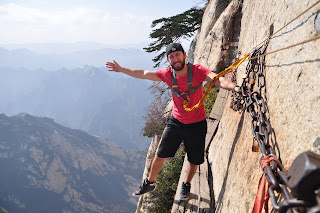Huashan, one of Taoism's five sacred mountains had lured us for quite some time. While still in Montreal, Josh had stumbled upon an article about China's Murder Mountain, having been notorious for the amount of deaths that occurred on its steep steps and kilometer cliffs. With some research, we found out it was called Huashan and was not too far from Xi'an. Josh had showed Winnie some pictures and he instantly wanted to join us.
Before we knew it, we were on a bullet train and in 20 minutes we were near the base of Huashan, some 120km away. Man I love that train!
We started our ascent from the village of Huashan, following a 6km path leading up to the north peak. The climb was progressive and only began to get difficult after the first two-thirds. I was a little hesitant having Winnie join us considering he was 59 years old, but he really surprised us and held his own.
Hiking in China, at least sacred mountains implies stairs, hundreds of thousands of steps cut to various heights and widths, finding new ways to wreak havoc on your muscles and knees. Another unfortunate reality when hiking in China is the hundreds to sometimes thousands of people at the summit. Not because they are in amazing shape and into physical activity, but because each mountain has at least one cable-car carrying tourists and tour groups to the summit.
Once we reached the north peak (1615m), it was instantly evident that a cable-car terminated there by the sheer amount of people who greeted us. We quickly left and continued the climb towards the south peak, Huashan's highest at 2160m.
It is quite easy to see why this was once known as murder mountain because of the incredibly steep stairways, near vertical climbs and the then-absent handrails. Today, Huashan is a shadow of its former deadly self, having installed all the safety features necessary to minimize casualties. The only remaining danger I could see was if someone out of the thousands of people ascending or descending at any given time were to fall and start a domino effect down the steep stairs.
What's nice, however, is that most tour groups follow a rather predictable route, and at a pace which is very easy to overtake, leaving us with some breathtaking, unadulterated views of the surrounding landscape.
Before reaching the south peak, we did what we had come to Huashan for: scaling the cliff on three planks of wood.
The cliff that I'm speaking of is over a kilometer in the air and originally consisted of a chain bolted to the rock-face and three planks of wood to scale the cliff to reach a secluded temple.
Even though you are harnessed in, the width of the wooden planks and the fact you are over one kilometer above the ground, separated only by a few one-by-fours is still a bit scary. Also, the passage was obviously made for one pilgrim at a time and the fact that you have to repeatedly pass over or under people going in the opposite direction adds to the perception of danger.
Upon reaching the south peak, we took a break and admired the amazing scenery sprawling around us. From there we started our descent, jelly legs already setting in. We took a brief detour towards the west peak to admire the wedge of rock leading up towards the summit.
We told Winnie to imagine how good that first beer would be once we get back to the hostel and he was instantly a man on a mission. A Bavarian in search of beer? We couldn't keep up!
It was nearly 5pm by the time we had reached the north peak. To save our knees and to make sure we caught the train back to Xi'an, we took the cable car down.
When we got back to the hostel, we were greeted by Helinä, our Finish friend from Sanlitun, who had just arrived from Beijing.
The next day I made my way to the Little Goose Pagoda, a 43m structure built in 707 AD to house the scriptures of Yi Jing.
After this brief visit I got lost for around an hour before retracing my steps and just getting on a bus going in the opposite direction. The only consolation I got was seeing this sign that represents the current Sino-Japanese relations due to the disputed islands in the South China Sea.
That evening we wandered through the Muslim quarter until Winnie had to catch his train to do a Yangze river cruise. Helinä, Josh and I continued sampling Chinese Muslim (also known as Hui) specialties like skewered quail eggs, spicy octopus and delicious mutton and beef kabobs.
Josh and I saw some delicious potatoes stewing in chilies and chives and quickly ordered 2 packages. Unfortunately, they turned out to be cubes of fat, which were not as delicious as they originally appeared.
That evening Helinä, Josh and I went to the hostel bar and sampled their many shots including the flaming goose pagoda: essentially a 3-story flaming sambuca shot on steroids. I threw in the towel early, but Josh and Helinä continued to party until early in the morning.
Our final day in Xi'an was spent wandering the back streets in search of some good street food and mentally preparing for our 16-hour train ride to Shanghai. A nice relaxing way to finish off our Xiantastic time in this former imperial capital. Not too bad indeed.
























yikes!! looks scary, but incredibly rewarding.
ReplyDelete